Filip Lipiński
American Traces: Polish Art Informel, Tadeusz Kantor and the ‘Triumphs’ of Abstract Painting across the Iron Curtain
The article revisits the discussion around the Polish Art Informel in the late 1950s and early 1960s, with special attention given to “American traces”: discourses and events related to Cold War American cultural policy, which, aside from certain formal parallels between Polish and American abstraction, might have had an impact on the interpretation and origins of the Polish art during the so-called “Thaw” period. Instead of falling into a possible trap of seeking “influence” and “provenance”, implying hierarchy and clear-cut division into the center and periphery, the author proposes a more “horizontal” and complex approach to this transatlantic relation (referring to Piotrowski [2009], Pospiszyl [2017], Rampley [2021]), bringing forth local issues, disputes and interests that complicate the grand, “triumphant” narrative of the bipolar world of that time with its modernist underlining. The first part introduces the methodological premises of the paper and outlines its main tenets and goals. Next, the text introduces — and subverts — the founding myth of Polish abstraction with Tadeusz Kantor as its main protagonist. In the section “A view from the ‘center’”, the author reconstructs and revisits the reception of Polish art during the “Thaw” period in the American press, especially The New York Times, connected with exhibitions of Polish abstraction on both sides of the Iron Curtain. The text also makes problematic the west-east dichotomy, pointing to the autonomizing moment in the Polish cultural policy during the “Thaw”. Next, special attention is given to the famous 1961 Fifteen Polish Painters show at New York’s MoMA and its attendant critical discourses. “A view from the ‘periphery’” is a reconstruction of internal tensions in the milieu of the Polish avant-garde which turn out to sideline the Cold War framework. It also brings up the role of Paris in the reception of modern art in Poland in the USA. Then the article focuses on two dominant artistic figures, Tadeusz Kantor and Jackson Pollock, looking at the complicated attitude the former had towards the latter, possible parallels and differences in their art, artistic ideas and the way they were represented and how they were fashioned. Finally, the author concludes by highlighting different legacies that the seemingly similar artistic achievements resulted in, complicating the one-dimensional, “triumphant”, anticommunist narrative of abstraction in Poland.
Author's email:
fillipin@amu.edu.pl
DOI: https://doi.org/10.54759/ART-2025-0101
Full-text in the Digital Library of the Czech Academy of Sciences:
https://kramerius.lib.cas.cz/uuid/uuid:fd0b0e87-9853-4d2d-beaf-a6587a62f2bf_1
< back

